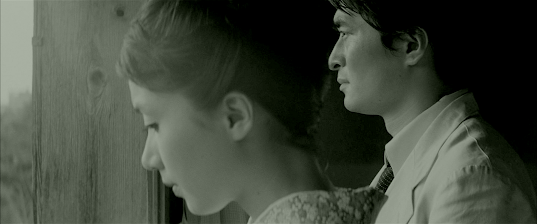Obscure Japanese Film #169
 |
| Shima Iwashita |
1937. After a prologue in which we see two soldiers deserting – one of whom is quickly captured – the story moves to Wajima, Ishikawa Prefecture. Matsuno (Shima Iwashita) is a 19-year-old virgin working as a maid at an inn, where she is best friends with another maid, the older and more experienced Ritsuko (Mayumi Ogawa). When Ritsuko leaves for a better-paid job as a hostess in Yamashiro Onsen 150 kilometres to the south, she invites Matsuno to go with her, but Matsuno decides to stay behind for the time being.
She then meets Kosugi (Tsutomu Yamazaki), a kindly travelling salesman who stays at the inn where she works for a few nights. When she learns that he will also be going on to Yamashiro and can help her find a job there, Matsuno decides to join Ritsuko after all. However, she’s unaware that Kosugi has deserted from the army and has a dogged military policeman (Kei Sato) on his trail…
Clouds at Sunset was based on an untranslated 1964 novel of the same name by Tsutomu Mizukami (or Minakami), whose work formed the basis for a number of interesting films, including The Temple of Wild Geese, Bamboo Doll of Echizen, A Story from Echigo, A Fugitive from the Past and Lake of Tears. Like the latter two, the film was adapted for the screen by Naoyuki Suzuki, a famously uncompromising screenwriter who frequently collaborated with Tomu Uchida and had won two awards for A Fugitive from the Past.
Directed by Masahiro Shinoda, like many of his films, Clouds at Sunset stars his wife, Shima Iwashita (in fact, the two are still married at the time of writing, aged 93 and 84 respectively). 26 years old when the film was made, she is nevertheless thoroughly convincing as the young and innocent Matsuno and won both the Kinema Junpo and Mainichi Film Concours awards for Best Actress for her performances in this and Portrait of Chieko. The other principals are also good, especially Mayumi Ogawa as her protective older friend (whom chance always seems to make unavailable at the crucial moment!).
As played by Tsutomu Yamazaki (the kidnapper from Kurosawa’s High and Low), Kosugi never comes across like the scumbag one would expect considering the despicable way he later uses Matsuno to save his own skin. It’s made clear that he does this out of desperation rather than malevolence, and Matsuno continues to love him anyway. Somehow, this escapes feeling like the usual dubious male fantasy and Shinoda wisely leaves it open to question whether Matsuno is merely hopelessly naïve or is actually the only one perceptive enough to recognise Kosugi’s better nature.
Although distributed by Shochiku, the company for whom Shinoda had been under contract until 1966, the film was the first independent production by Hyogen-sha, Shinoda’s own company. All the more reason, then, to wonder why this excellent film came to fall through the cracks and become perhaps the least-seen of Shinoda’s works in recent years.
Aesthetically, the film looks and sounds great thanks to its subtle Toru Takemitsu score and the often beautiful cinematography of Masao Kosugi which, appropriately, bursts into colour at each sunset.
Thanks to A.K.
























